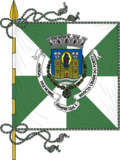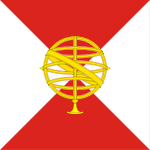Portuguese vexillology
Portuguese vexillology is the use of flags in Portugal. It originates from the early battle standards of medieval Portugal.
Characteristics
In relation to subnational flags, the rule is that they are gironadas or smooth coat with five towers if the municipality or parish is headquartered in a city (cidade), esquarteladas or smooth coat with four towers if the municipality or parish is based in a town (vila), and quartered or smooth coat with three towers if it is a municipality based in a village (aldeia) or is an urban neighborhood of a town or city.
Also in accordance with the Portuguese heraldry, flags can be sub oitavadas, hexagonal, esquarteladas in sautor, pad or track and still having the same color-field constants of the shield and the center estentendo stuff or a geometric figure where the coat of arms is applied.
 Porto (gironada)
Porto (gironada) Santo Tirso (smooth)
Santo Tirso (smooth) Resende (Quartered)
Resende (Quartered)
An exception presented here is the flag of Lagos, which is divided into franchado, which reflects the historical influence of King Manuel I in the region.
 Lagos (franchada)
Lagos (franchada) Personal Standard of King Manuel I
Personal Standard of King Manuel I
See also
Sources
External links
| Wikimedia Commons has media related to |